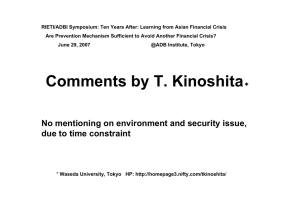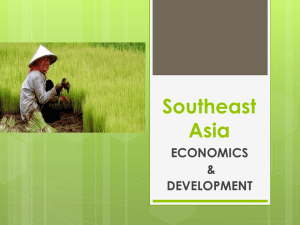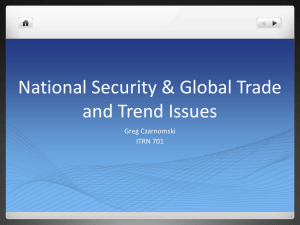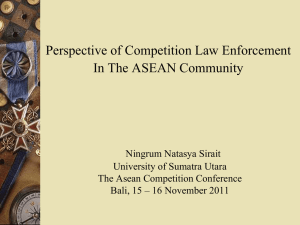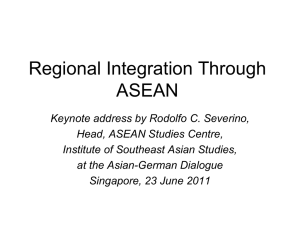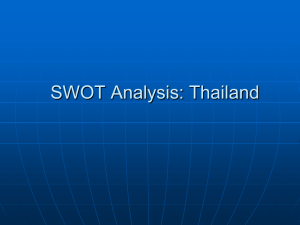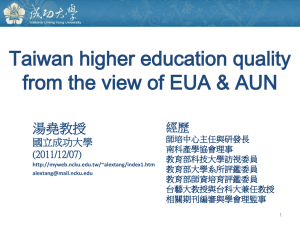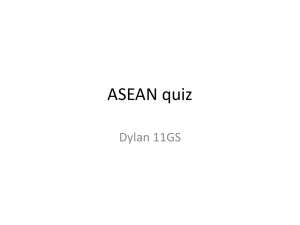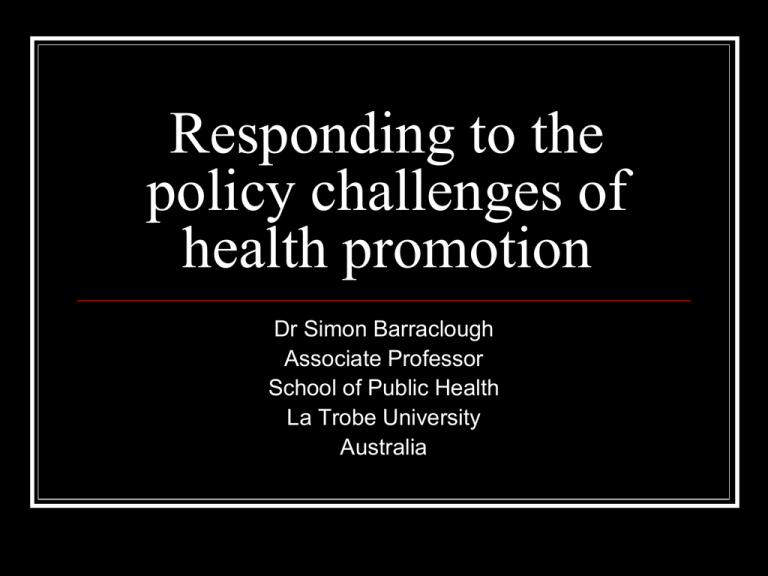
Responding to the
policy challenges of
health promotion
Dr Simon Barraclough
Associate Professor
School of Public Health
La Trobe University
Australia
What is health promotion
“Health Promotion is the process of enabling people
to increase control over their health and its
determinants and thereby improve their health. It
is a core function of public health and contributes
to the work of tackling communicable and noncommunicable diseases and other threats to
health”
The Bangkok Charter for Health Promotion in a Globalized World (2005)
“Bridging the Gap” requires policy
Millau Bridge, France
Thinking about gaps
Between richer and poorer
Between urban and rural populations
Between ethnic groups
Between the sexes
Implementation gaps
Evidence is not implemented in practice
Knowledge and evidence that exists on the
effectiveness of heath promotion strategies is not being
sufficiently applied.
Evidence on health impact is not applied to public
policy
Health should be integrated across broader economic
and social development policies in order to act on social
determinants of health.
Countries have insufficient capacity to put health
promotion into practice
Health systems should invest in sustainable capacity
and infrastructures for health promotion.
No matter what your role in health
promotion I want you to become policy
advocates
1.
2.
I want to persuade each one of you in
your personal lives and occupations to
consider yourselves as advocates for:
Better public policies for health promotion
Better and more inclusive processes for
making public policies affecting health
Policy is essential for health
promotion
The first and basic
principle of the Ottawa
Charter for Health
Promotion:
“Build healthy public
policy”
Policy knowledge and skill is vital
“Empowering individuals demands more
consistent, reliable access to the decision
making process and the skills and
knowledge essential to effect change”
Jakarta Declaration on Leading Health Promotion into the 21
Century (1997)
Policy is political
“Progress towards a healthier world requires
strong political action, broad participation
and sustained advocacy”
The Bangkok Charter for Health Promotion in
a Globalized World (2005)
What is policy?
“Those decisions made at all levels and
sectors of government which shape
social, economic and physical activities
and directions through regulation or
resource allocation”
Victorian Better Health Commission, Promoting Health and Preventing Illness in Victoria: A Framework,
Health Department Victoria, 1991
The health field concept
Human
Biology
Environment
Lifestyle
Health
care
Source: Marc Lalonde “The Health Field Concept” in Anne Crichton, Health Policy Making:
Fundamental Issues in the United States, Canada, Great Britain, Australia, Ann Arbor:
Health Administration Press, 1981
Human Biology
Knowledge about biological functions
including sex education
Screening for illness prevention
Encouraging human organ donation
Environment
Pollution
Carbon emissions
Vector control
Green belts
Hygienic food preparation
areas
Recreation facilities in the
built environment
Deforestation
Plastic bags and bottled
water
Lifestyle
Condoms
Violence
Road accidents
Alcohol
Illicit drugs
Smoking
Advertising “junk”
foods
The challenge of NCDs in SE Asia
An estimated 2.6 million people from ASEAN
Countries died from chronic non-communicable
diseases in 2005 (almost 61.5% of deaths)
With ageing of populations prediction of an
estimated 2.6 million people from ASEAN
Countries died from chronic non-communicable
diseases in 2005 (almost 61.5% of deaths)
With ageing of populations, prediction of 4.2
million deaths by 2030
Dans et al. The rise of chronic non-communicable diseases in Southeast Asia: time for
action
The Lancet Vol.377, February 2011:680-689
Three major behavioural factors that predict
NCDs are:
Tobacco use
Inappropriate diet
Insufficient physical activity
Some examples of Malaysian lifestyle
challenges
More than 80% of ASEAN inhabitants including Malaysians
consumes fewer than 5 servings of fruit and vegetables daily
Smoking in Malaysia was twice as prevalent in the poorest
quintile (approx. 32%) of the population compared to the
richest
Malaysia topped the ASEAN league for insufficient physical
activity (15%)
Malaysian estimated rates of diabetes (20-79 year old
population) 11.6 – the second highest in ASEAN after Brunei
(12.6%)
Cited in Dans et al. 2011
Challenges: Health promotion is the
“poor cousin”
Ministry of Health gets 8% of national budget
and prevention, promotion and public
health services get just 6.8% of the
Ministry’s budget
Curative health dominates
Doctors, hospitals and
pharmaceuticals are the main
concerns of health systems in
terms expenditure, staffing,
and how people think of health
Curative care is an important
economic commodity
Malaysian governments are a
significant investor in private
commercial hospitals
Medical dominance of the
policy process does not
always serve the interests of
health promotion
Lower status of health ministries
The Ministry of Health usually has a lower
status in governments
In Australia the portfolio of health is usually
given to a middle ranking politician
In Malaysia the portfolio is traditionally
reserved for the MCA
Health promoters are often not
“political animals”
Government servants
are nervous about
their role in policy
making and of forming
links with civil society
Many people in health
promotion have not
had policy experience
and lack knowledge
about policy
The policy making process in
Malaysia
In Malaysia, as in many countries until recently, there has not been a strong
culture of involving civil society in the health policy process
In the 1980s the government legislated to try to control the political role of nongovernment organizations
Over secretive culture: the Official Secrets Act can still be invoked and NGO
representatives are sometimes forbidden to publicly or privately discuss the
results of consultations with government ministries
Processes lack transparency
Access to policy information is not adequate
Mass media has limited independence
The challenge of agenda setting
It is difficult to get some issues on to the
agenda due to cultural, religious and
political sensitivities
Political skill is needed
The “policy story” needs to be told in an
appropriate way sometimes stressing
human rights and humanitarian values,
sometimes appealing to economic
rationality
Evidence-based policy
Evidence requires research and takes time and money
Health promotion often has a very long term time frame and
results are not seen for years or even generations
Malaysians often have to depend upon evidence from other
countries since there is limited research
Evaluation is an important part of policy design
Vested interests will dispute the evidence (eg advertising junk
food to children; passive smoking)
Health promotion polices sometimes
face opposition due to conflicting
values
Resentment of intrusion
of the government with
calls to prohibit “junk
food” advertising to
children on TV or what
may be sold in school
canteens
Taxation of high fat, high
sugar foods?
Policies can have unintended
consequences
In Australia, Victorian law
requires a helmet be worn
by all cyclists to reduce
head injuries
Melbourne City Council
has spent millions
installing bicycle stations
where with a credit card
you can rent a bike to
travel around the city
but uptake has been poor
due to the helmet
requirement
The challenge of policy advocacy
Policy can be in the form
of advocating changes in
behaviour
Advocacy is a relatively
economic form of policy
action
In Australia organ
donation advocacy has not
been as successful as in
other countries
Conflict with vested interests
The Australian Government
is enacting legislation to
force tobacco packages to
be in dull olive green with
no logos, trademarks or
distinctive writing
Tobacco companies are
running a counter
campaign, threatening
legal action, and will take
Australia to the World
Trade Organization
The challenge of international and
regional policy cooperation
Globalization calls for greater
international cooperation
in health promotion policy
Bilateral
WHO
ASEAN
The Commonwealth of
Nations
Organization of Islamic
Conference
The challenge of inter-sectoral
cooperation
“There is a clear need to break through
traditional boundaries within government
sectors, between governmental and
nongovernmental organizations and
between public and private sectors”
Jakarta Declaration on Leading Health
Promotion into the 21 Century (1997)
What is needed
Do not be afraid to be political as this is part of policy making
Be committed to influencing policy and to implementing it
effectively
Develop greater knowledge about how policy is made
Develop policy skills and strategy
Have a greater awareness of the need for evidence in policy
making
Recognize the value of greater plurality and openness in the
policy process
Make health promotion part of all policy thinking


